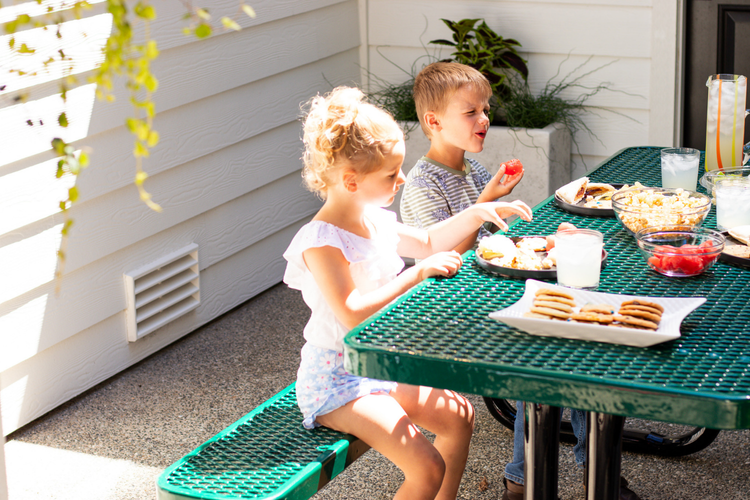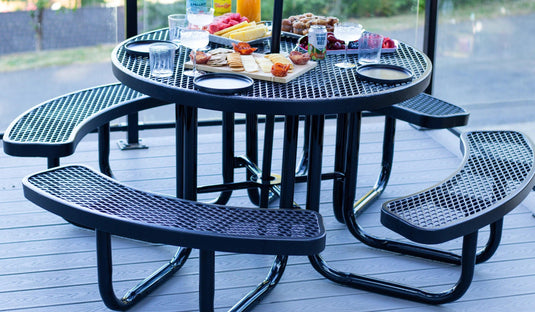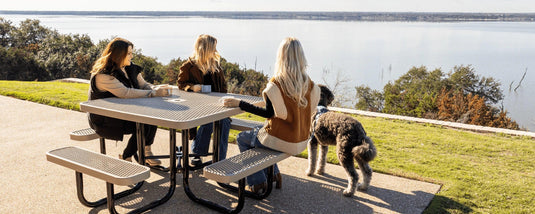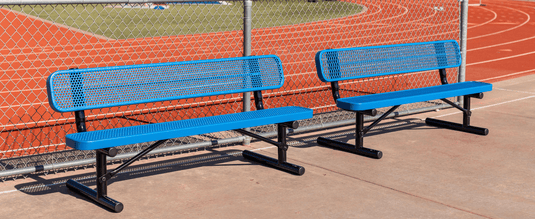When shopping for commercial outdoor furniture, a lot of buyers find themselves comparing polyethylene-coated steel to aluminum. Both are metal, both are popular, and both claim to be durable—but there are some major differences you’ll want to consider, especially for high-traffic public spaces.
Whether you're furnishing a park, school campus, restaurant patio, or corporate outdoor area, here's a side-by-side comparison to help you make the best choice for your space.
1. Durability: Which Material Holds Up Better?
Aluminum is lightweight and naturally resistant to rust, which makes it a solid option in coastal areas or damp environments. But it dents and bends more easily than other metals, especially in places with high foot traffic or rough use.
Polyethylene-coated steel, on the other hand, is much tougher. The steel core gives it strength and weight, while the polyethylene coating seals it from moisture and damage. It’s designed for decades of use, not just a few seasons.
👉 Verdict: If you're planning for the long haul (especially in public spaces), coated steel is built to last longer and look better while doing it.
2. Weight & Stability
Aluminum’s light weight can be an advantage for portable furniture or pop-up events, but that same feature is a drawback in windy areas or places where theft is a concern. Aluminum chairs and tables can blow over or "walk off" more easily than heavier alternatives.
Coated steel furniture is heavy enough to stay put, giving you peace of mind that it won’t tip, topple, or disappear overnight. It’s the ideal choice for parks, schools, and other unsupervised public environments.
👉 Need furniture that stays where you put it? Go with coated steel.
3. Maintenance & Wear
While aluminum doesn't rust, it can oxidize and fade over time, especially when powder-coated. Scratches are more visible, and once the coating wears thin, it can start to corrode in salty or humid conditions.
Polyethylene-coated steel requires very little maintenance. The thick plastic-like coating resists UV rays, moisture, scratches, and graffiti. A quick wash with soap and water is usually all it needs to look brand new again.
👉 Winner: Coated steel is far easier to keep looking fresh—no repainting or retouching needed.
4. Comfort & Safety
Aluminum furniture, especially when uncoated or poorly insulated, can get hot in the summer and cold in the winter, making it less comfortable to use. It also tends to have sharper edges or thinner frames, which aren't always ideal for kids or casual users.
Polyethylene-coated steel furniture is smooth, rounded, and splinter-free, with a slightly softer surface that doesn’t absorb heat or cold the same way metal does. It’s safer and more comfortable, especially for schools, playgrounds, and family-friendly spaces.
👉 Comfort matters—coated steel provides it.
5. Style & Customization
Aluminum tends to have a sleek, modern look, and it works well in spaces where minimalism is the goal. But color options are limited, and once the finish wears out, it’s hard to refresh.
Coated steel furniture comes in a wide range of vibrant, fade-resistant colors—perfect for brand alignment or community themes. Want red picnic tables in a playground or deep blue benches in a coastal park? You’ve got options.
👉 Steel wins in color, personality, and long-term visual appeal.
6. Cost & Value Over Time
Aluminum is often cheaper up front, which can be tempting. But when you factor in replacement costs, repairs, and upkeep, it may not be the best long-term value.
Polyethylene-coated steel furniture costs a bit more initially, but it pays off in decades of durability, reduced maintenance, and fewer replacements.
👉 Total cost of ownership? Steel is the smart investment.
Final Thoughts
Aluminum may be the right choice for some short-term or residential settings. But if you’re furnishing a public, high-traffic, all-weather space and you want your furniture to last with minimal maintenance, polyethylene-coated steel comes out ahead, hands down.
Take a look at our full range of coated steel furniture here, or contact us to talk about the best fit for your space.





